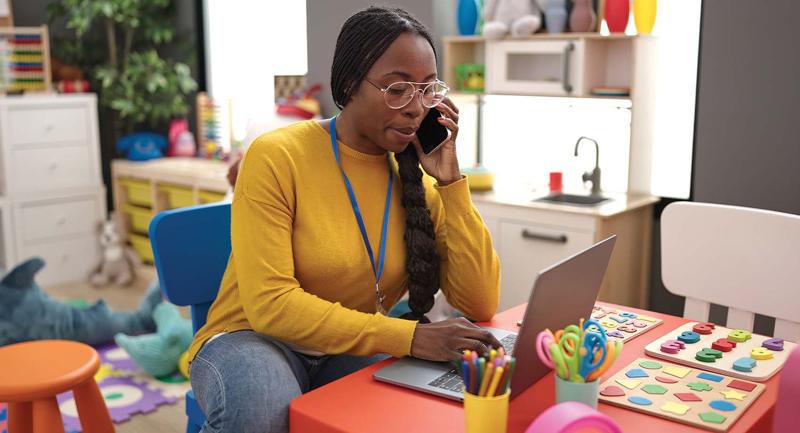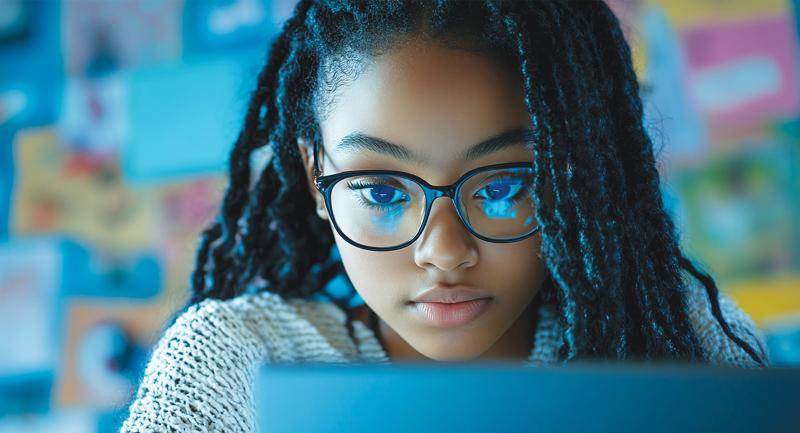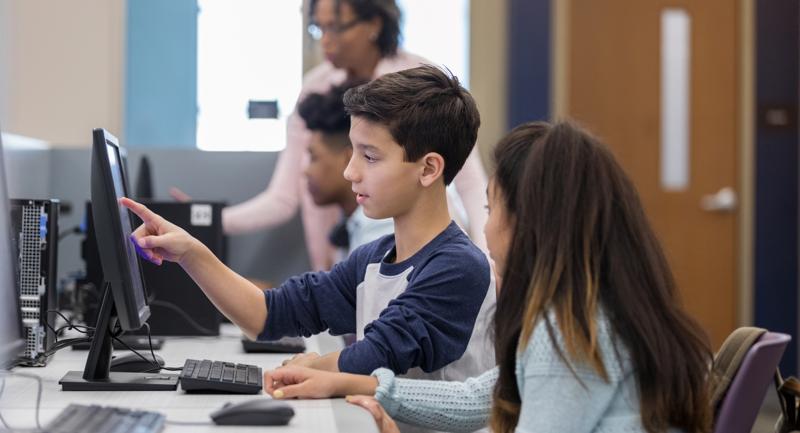After 10 weeks of COVID-19-induced distance learning at her desk in her room, I asked my 3rd grade daughter Sonia for her perspective on her experiences. An avid writer herself, she volunteered a whole page about her observations. Perfect! I thought. An unfiltered and authentic child's point of view! She came back with a rolled piece of paper labeled with "Distance Learning" on the top, and four words in giant letters filling the entire page: "I MISS MY FRIENDS."
Like most human endeavors, learning is inherently social. Young children learn by playing, observing, and actively engaging in communities of kids. Being together with other children is so crucial for young children's learning, development, and well-being that the American Academy of Pediatrics has urged policymakers to prioritize getting kids back together in classrooms as soon as is safely possible. The risks of social isolation, they have claimed, could rival the risks of the coronavirus itself (Kaymenetz, 2020).
But since the pandemic continues to prevent many schools from opening fully for in-person learning, how can educators incorporate social interaction, play, and self-determination into our youngest learners' days while they are sitting in front of a computer screen?
The Potency of Play
To answer this question, we must first look at why playing with friends is so potent for learning. It has to do with the dynamic, free, and self-determined nature of play. In play, a child can immerse him or herself in a situation and react in an unlimited number of ways. A child can hypothesize or imagine many possible new situations, stretching ideas, theories, and behavior patterns in response. When children do this together, the possibilities for imagining and creating expand exponentially. Play also allows children to practice key social skills, such as negotiating rules in real time, sharing power, switching gears, and trying on different roles.
Play is most complex when it is autonomous—free from meddling adults. In fact, research shows that children use significantly more sophisticated language skills and more complex imaginative scenarios when they play in a group that does not include adults (Pellegrini & Holmes, 2006).
Formal learning is also most effective when it is self-determined, or driven by the learners. As a matter of fact, the best predictor of academic excellence is not whether a child meets a teacher's prescribed benchmarks or learning outcomes, but rather the level of that student's excitement and joy for learning (Kohn, 2018). Examples of this principle abound in the child development research literature. In one recent study, when students were required to keep a reading log or told what books to read, their interest in reading and reading depth decreased significantly (Pak & Weseley, 2012). In a distance-learning situation, which lacks the three-dimensional and embodied social cues that humans usually rely on to perceive and learn (Murphy, 2020), awakening students' authentic interest becomes even more important.
But it is not easy for educators working remotely to replicate the in-person classroom experiences that encourage play, autonomy, and experimentation in our youngest learners. Since synchronous distance-learning sessions are almost always led by teachers, they allow for very little play and self-determination. Any creative, spontaneous, or silly play that does happen is often quickly shut down. For example, when 2nd graders were doodling on the whiteboard during a Zoom meeting I recently observed, one teacher responded by disabling the whiteboard feature because she saw it as a distraction from the lesson plan.
But another class period showed a way to give children the free space they need. Once the whiteboard was disabled, the teacher asked the children to hold their ideas for 10 more minutes. When the lesson was completed, she set them free to use the whiteboard feature however they wanted. The children almost instantaneously created a complex drawing game using the "shapes" stylus. First, a boy made a person whose whole body was made of circles. Another child challenged him to try to make a dog, entirely out of different-sized stars. Next, these characters became the basis for stories that the children began to invent.
What ensued was arguably the best learning experience of the day—a self-determined game that involved negotiating rules and power dynamics; fine motor skills and creativity; divergent and flexible thinking; and collaborative storytelling using shifting narrative and voice. Building a bit of free play into the distance-learning lesson plan allowed the children to meet their cognitive, social, and emotional needs with independence.
Deep Learning at a Distance
The ingredients for young children's learning remain constant, regardless of the setting. During remote learning, these ingredients are even more crucial because the learning environment itself is so diminished, compared to the setting in which children's brains have evolved and developed. For tens of thousands of years, healthy, growing children would typically spend much of the day outside, running around with friends in a sensory milieu which includes dynamic emotional interactions, almost constant real-time problems to solve, exploration, and surprise. Likewise, any in-person school day involves an incredibly complex, social, and perceptual environment. How can we champion those necessary ingredients—social, playful, and self-determined learning—at a distance? Here are some ideas to keep in mind.
Make it collaborative. Children need to grow and learn with other children. If we must do distance learning for all or part of the school week, then any way to make that learning social is a win. As over 30 years of educational research has shown, deep and lasting knowledge is constructed collaboratively in communities of learners (Watkins, 2005).
Teachers can create small groups of students in online breakout rooms for assignments, ranging from math to art. Or they can organize their own social groups via online games. To stave off remote-learning isolation, 2nd grade teacher Rosa Maria Loaiza has set up learning buddies in her class. The pairs of students meet in breakout rooms on Zoom every morning after their whole-class morning meeting to plan how they will collaborate that day. Some pairs spend the entire day working together on their assignments and projects. Others collaborate in a particular area in which they enjoy support, like on math problems, and then separate for other subjects.
At their class-closing Zoom meeting, the students check in with their partners once again in breakout rooms, and then share with their teachers where they've been successful and where they are struggling. Learning-buddy pairs are sometimes connected with other pairs to form larger groups for projects, but having that one, special point person has been both comforting and empowering for Ms. Loaiza's 2nd graders.
Let the kids choose the topics and the process. When we humans become fearful, we become more controlling in the areas within our purview. Research shows that parents and teachers who are actively fearful about kids' well-being (often with good reason, like in a global pandemic), are much more likely to use tightly controlled learning methods (Robichaud et al., 2019). This makes logical sense, but ironically it harms the children—thwarting their deep need for autonomy and competence and disrupting their natural motivation (Soenens & Vansteenkiste, 2010; Van Der Kaap-Deeder et al., 2019).
We need to recognize just how competent our young children are at learning (better than adults, in fact, at learning the most complex of cognitive skills, including languages and musical instruments). When someone believes in you as a learner, it sets you free to be experimental.
Teachers can allow students the freedom to choose the topics they are genuinely interested in and excited about. If the goal is skill building, why not let them develop skills while delving into something they want to learn about? For example, a student interested in sharks or baking can take that interest seamlessly into math or history or science. You might vote on a topic as a class, or you might survey the group and find out what excites the children the most. Pair up kids who have similar interests, set them up on their own Zoom or FaceTime call, and guide them on their exploration together.
You can also allow kids to choose how they prefer to learn. Within a topic area, provide menu options of how children can approach the topic. If you are studying the Civil Rights Movement, for example, ask the children to choose whether they would like to create a board game, make a protest sign, or assemble a diorama. You can have them choose three activities from a list or propose an idea of their own. Let them set, evaluate, and reflect on their own goals (McTighe & Martin-Kniep, 2020).
Be their muse. It can be a challenge for students to get inspired without the usual vibrant and multisensory energy of a classroom surrounding them. But enthusiasm can also be contagious, and you can model that as a teacher. I find this to be very effective with my college students during remote learning. For every topic or reading that we are about to encounter, I entice them with little previews and teasers in advance. For instance, I tell them the story behind why I chose a certain book, how it contains surprises and even shocks, how it will blow their minds and maybe even change them forever! Since many of our students are feeling lonesome learning at home, they may need an extra "hook" or invitation to become engaged.
Find fun and funny short videos to entice your students about a topic. Tell them about an interest you had in that specific domain when you were their age, or how you came to think differently about a topic area. When he starts his units on arthropods, 3rd grade science teacher Adri Singh always tells his class the story of how he was deathly afraid of spiders as a child. He says that just that little bit of personal information connects his class to the intimate nature of learning together as a community; the sense that "we are all in this together." Even opening up and sharing your physical space with your students (as appropriate) can function as a personalized invitation to engage. They will be fascinated by who you are as a person, what your house looks like, what hobbies you do in your spare time.
Mix up how they use their time. Learning online can quickly get monotonous if students do the same thing every day. Try using different time schemes in a given day. Let kids occasionally manage their own time. Let them decide how much time a given project should take, and then let them go back and revise their plans based on their successes and challenges. Learning to manage one's own time is one of the best gifts we can give children—it will pay dividends in self-regulation and executive functioning skills.
Another concern about remote learning—for both teachers and parents—is the amount of screen time children are suddenly getting. While we know from child development research that screens are not harmful to children in and of themselves, sitting in front of a screen all day is not what we want our youngest learners to be doing. Distance learning for young children must use different modes of engagement: alert screen time, soft and quiet time, and rambunctious play time (such as asking kids to run and find a few items for a scavenger hunt or organizing a "relay" race that involves jumping jacks or dancing).
Research on screen time reveals that it's not so much about the amount of time as it is about whether the learning is active or passive. One study showed that toddlers learned novel words and improved language skills from video chats and live interactions, but not from passive videos (Roseberry, Hirsh-Pasek, & Golinkoff, 2014). More recently, children's passive screen time was negatively associated with their mathematics achievement, science performance, executive functioning, and social skills; however, active screen time was positively associated with their receptive language and science knowledge, reading comprehension, and math skills (e.g., Hu et al., 2020; Neumann, 2014). Instead of counting the minutes that children are on screens, we should focus on what kids are doing with devices, and whether those hours include the requirements for deep learning.
How Do We Want Them to Learn?
The COVID-19 pandemic has created a powerful naturalistic experiment. Thrust into a new reality, we now have the opportunity rethink both how we have been teaching and learning and how we want to teach and learn. As we remake our curricula for remote and hybrid learning formats, it is essential to prioritize those activities that we know lead to deep, long-lasting learning in children. Both education and cognitive science research show that kids learn best together in social groups, like learning communities. Likewise, play and the sense of autonomy, risk, and experimentation are absolutely essential for children's learning. Now more than ever, as children are missing their friends, teachers, and classroom spaces, let's maximize their authentic learning by setting up their school days in playful, free, and collaborative ways.
Reflect & Discuss
➛ Is play for early learners a priority at your school? How has that changed since the pandemic?
➛ What are your best ideas for incorporating social activities into your remote learning lesson plans?
➛ What passions, projects, or ideas of your own can you share with students to make them excited about learning?









